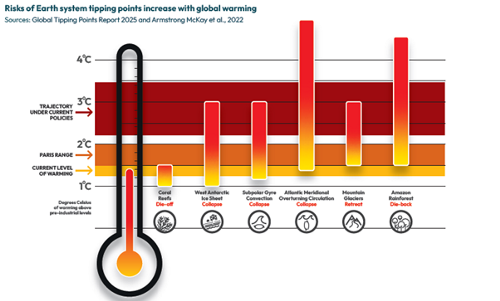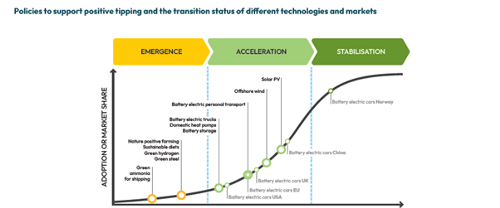The world has entered a new reality. Global warming will soon exceed 1.5°C. This puts humanity in the danger zone where multiple climate tipping points pose catastrophic risks to billions of people.
Already warm-water coral reefs are crossing their thermal tipping point and experiencing unprecedented dieback, threatening the livelihoods of hundreds of millions who depend on them.
Polar ice sheets are approaching tipping points, committing the world to several metres of irreversible sea-level rise that will affect hundreds of millions.
Every fraction of additional warming increases the risk of triggering further damaging tipping points. These include a collapse of the Atlantic Meridional Overturning Circulation (AMOC) that would radically undermine global food and water security and plunge northwest Europe into prolonged severe winters. Together, climate change and deforestation put the Amazon rainforest at risk of widespread dieback below 2°C global warming, threatening incalculable damage to biodiversity and impacting over 100 million people who depend on the forest.
These climate tipping point risks are interconnected and most of the interactions between them are destabilising, meaning tipping one system makes tipping another more likely. The resulting impacts would cascade through the ecological and social systems we depend upon, creating escalating damages. Humanity faces a potentially catastrophic, irreversible outcome. The Inter-American Court of Human Rights recognises the right of humans to a safe climate, hence preventing irreversible harm to the climate system is a legal imperative.

If we wait to cross tipping points before we act, it will be too late. The only credible risk management strategy is to act in advance. But the window for preventing damaging tipping points is rapidly closing. Current Nationally Determined Contributions (NDCs) and binding long-term or net-zero targets are not enough. They still commit the world to ongoing global warming that will likely exceed 2°C before 2100. This demands immediate, unprecedented action from leaders at COP30 and policymakers worldwide.
To achieve such a radical acceleration of action requires triggering positive tipping points that generate self-amplifying change in technologies and behaviours, towards zero emissions.
This is clearly evident in clean technology adoption. Solar PV panels have dropped in price by a quarter for each doubling of their installed capacity. Batteries have improved in quality and plummeted in price the more that are deployed. This encourages further adoption. The spread of climate litigation cases and nature positive initiatives is also self-amplifying. The more people undertaking them the more they influence others to act.

A total of 160 authors, from 23 countries and 87 institutions contributed to this report. Together, we’ve consolidated knowledge on how to govern Earth system tipping points, the risks they pose, and the opportunities presented by understanding and acting on positive tipping points
Download the report here: https://global-tipping-points.org/
Posted 16/10/2025
















